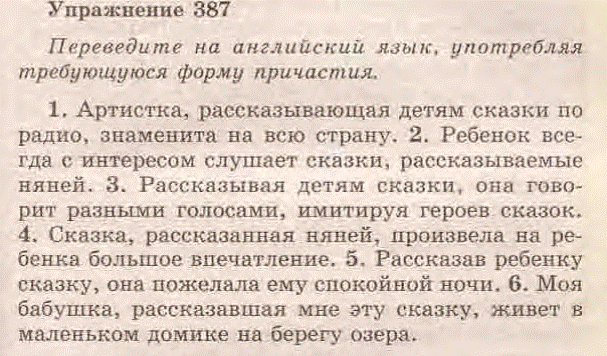Translate the text from English into Russian
AGRICULTURAL MACHINERY
Agricultural machines are used to till soil and to plant, cultivate, and harvest crops. Since ancient times, when cultures first began cultivating plants, people have used tools to help them grow and harvest crops. They used pointed tools to dig and keep soil loosened, and sharp, knife-like objects to harvest ripened crops. Modifications of these early implements led to the development of small hand tools that are still used in gardening, such as the spade, hoe, rake and trowel, and larger implements, such as ploughs and larger rakes that are drawn by humans, animals, or simple machines.
Modern machinery is used extensively in Western Europe, Australia, the United States, the Russian Federation and Canada.
Modern large agricultural implements, adapted to large-scale farming methods, are usually powered by diesel- or petrol-fuelled internal-combustion engines. The most important implement of modern agriculture is the tractor. It provides locomotion for many other implements and can furnish power, via its power shaft, for the operation of machines drawn behind the tractor. The power shafts of tractors can also be set up to drive belts that operate equipment such as feed grinders, pumps, and electric-power generators. Small implements, such as portable irrigators, may be powered by individual motors.
Implements for Growing Crops
Many types of implements have been developed for the activities involved in growing crops. These activities include breaking ground, planting, weeding, fertilizing, and combating pests.
Ground is broken by ploughs to prepare the seed-bed. A plough consists of a blade-likeploughshare that cuts under, then lifts, turns, and pulverizes the soil. Modern tractor ploughs are usually equipped with two or more ploughshares so that a wide area of ground can be broken at a single sweep. Harrows are used to smooth the ploughed land and sometimes to cover seeds and fertilizer with earth. The disc harrow, which has curved, sharp-edged steel discs, is used mainly to cut up crop residues before ploughing and to bury weeds during seedbed preparation. Rollers with V-shaped wheels break up clods of soil to improve the aeration of the soil and its capacity for taking in water.
Some cereal crops are still planted by broadcasting seeds—that is, by scattering the seeds over a wide area. Machines for broadcasting usually consist of a long seed-box mounted on wheels and equipped with an agitator to distribute the seeds. Broadcast seeds are not always covered by a uniform or sufficient depth of soil, so seeding is more often done with drills, which produce continuous furrows of uniform depth. Specialized implements called planters are necessary for sowing crops that are planted in rows, such as maize. Maize planters and other similar machines have a special feed wheel that picks up small quantities of grain or separate kernels and places them in the ground.
Fertilizer can be distributed during the winter or shortly before seeding time. Commercial fertilizers are commonly distributed, along with seeds, by drills and planters. Manure is distributed most efficiently by a manure spreader, which is a wagon equipped with a bottom conveyor to carry the fertilizer back to a beater attachment, which disintegrates it and then scatters it on the ground.
After crops have begun to grow, a cultivator is used to destroy weeds and loosen and aerate the soil. A flame weeder, which produces a hot-air blast, can be used to destroy weeds growing around crops, such as cotton, that have stems of tough bark. The weeds are vulnerable to the hot air, but the tough stems protect the crops from damage. Chemical herbicides applied in the form of a spray or as granules are used extensively for weed control.
Insecticides for pest control are applied to soil and crops in the form of granules, dust, or liquid sprays. A variety of mechanical spraying and dusting equipment is used to spread chemicals on crops and fields; the machinery may be self-powered, or drawn and powered by a tractor. In areas where large crops of vegetables and grain are grown, aircraft are sometimes used to dust or spray pesticides.
Chemical pesticides are used in nearly all farming operations undertaken in developed countries. However, increasing concern over the harmful effects that pesticides may have on the environment has led to the use of alternative forms of pest control. For example, farmers use crop rotation to prevent pests that feed on a certain crop. Also, certain pests are controlled by introducing an organism that damages or kills the pests, but leaves the crops unharmed. Finally,some crops are being genetically engineered to be more resistant to pests.
Implements for Harvesting Crops
Most cereal crops are harvested by using a combine— a machine that removes the fruiting heads, beats off the grain kernels, and cleans the grain as the combine moves through the fields. The cleaned grain is accumulated in an attached grain tank.
Wheat and other cereal crops are harvested by a combine which, as it moves along the rows, picks the ears from the stalks and husks them. The ears are then transferred either to a sheller, which removes the kernels from the ear, or to a vehicle trailing behind the machine.

Переведите следующие предложения в зависимости от формы сказуемого в главном и придаточном предложениях:
1. Should it be desirable to divide the powder of two
substances, several ways are possible.
2. It would be worth while investigating the substance
mentioned, provided we could get it in sufficient quantity.
3. Should your work meet these conditions, it will be of
great service to our industry.
4. Unless the cathode Сis water cooled, it will overheat
and emit gases.
5. Had it not been for a large size of this body, we should
have already weighed it on our pan.
Вариант 2
